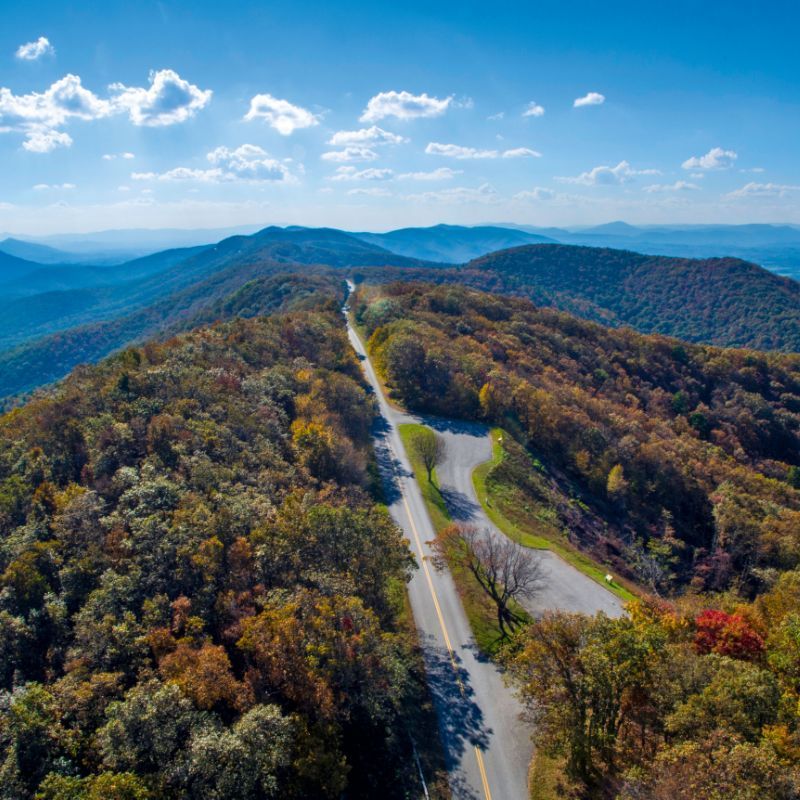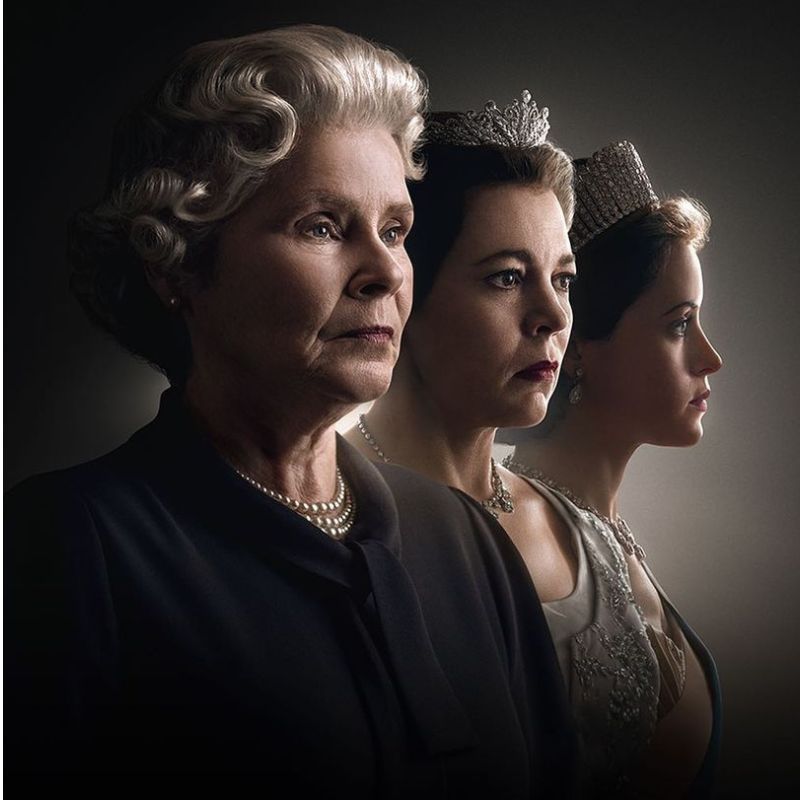
South America disappeared while I was at dinner. In the dwindling twilight, our cruise to Antarctica had been haunting the coast of Tierra del Fuego, an archipelago that makes up the continent’s southernmost tip. I had wanted to see Cape Horn, once the end of the known world, but had lingered too long over the roast lamb with that wonderful Pinot Noir. When I eventually went out on the deck, South America had slipped astern.
The night was black and rain-swept; I needed to hold the rail to keep my feet. Standing in the open bow, away from the candlelight and the pressed linen and the reassuring murmur of conversation, there was a sense of uneasy anticipation. A heaving, whitecapped sea unfurled streaks of spray. We were in the Drake Passage, one of the planet’s most fearsome stretches of sea. I peered into the darkness. It was as if we were sailing beyond the normal parameters of our world. I thought of the explorers of the early 20th century who made this same crossing in small wooden ships, brave but perhaps a little deranged.
Here’s what the itinerary of the Antarctica expedition cruise includes
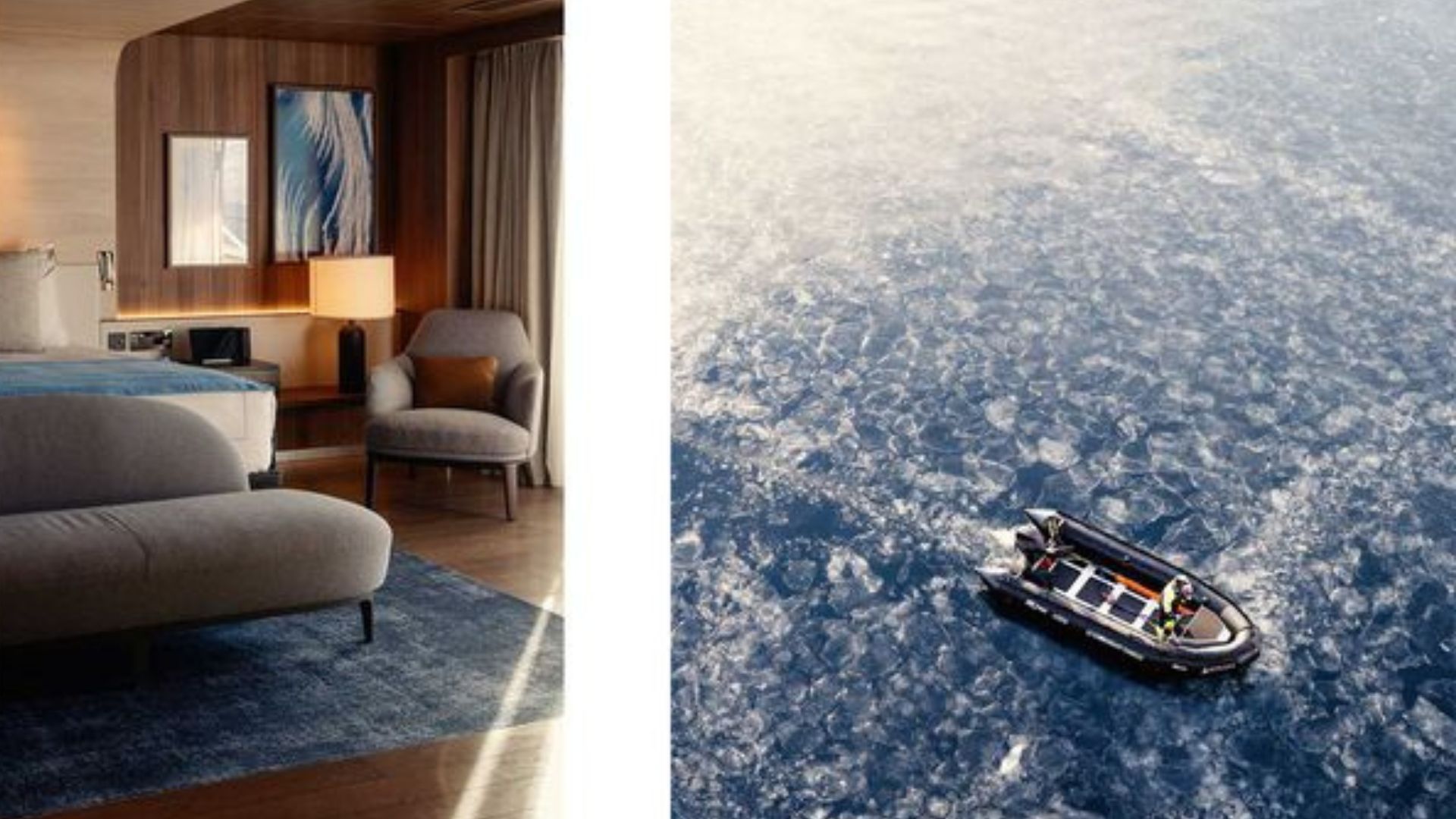
It took humankind a while to find Antarctica. For a couple of millennia, civilisations from ancient Greece to Polynesia talked of Terra Australis Incognita — the Unknown Southern Land — as little more than a rumour. In 1773, Captain Cook groped his way through the fog and icebergs of the Southern Ocean, hoping to stumble upon the continent. He returned defeated, and unimpressed. Whatever is down there, he wrote, was “doomed by nature.”
Discovery in 1820 — hats off to Captain Bellingshausen of the Russian navy — opened the gates to the last great age of heroic exploration, the empty continent firing the imagination of a generation of adventurers. Chaps with frozen beards and thousand-yard stares couldn’t get enough of the place. They came from all corners of the world, from Britain, Norway, Japan, Australia, Russia, Germany, and the United States. Wrapped in furs and undeterred by a diet of whale blubber, they camped on ice floes and staggered through snowstorms to see who could be the first to reach the pole, or to cross the continent, or to lose their toes to frostbite.
Nothing prepares you for Antarctica. It is a continent of superlatives, the world’s most extreme environment, alien, surreal, elemental, a place of magnificence and spectacle.
But it was never just about the snow and ice, the challenging physical realities. This was the last great unknown, the last blank on the map. Sir Ernest Shackleton, arguably the greatest Antarctic explorer, who would eventually die in these latitudes, understood that Antarctica was always a metaphor on whose blank expanse one could chart one’s own significance. “We all have our White South,” Shackleton once said.
I was heading for my own White South on Le Commandant Charcot, one of the newest ships from the French luxury cruise line Ponant going to Antarctica. We sailed from Punta Arenas, the largest city in southern Chile, on an 18-day itinerary that would take us to the South Shetland Islands, the Antarctic Peninsula, and the island of South Georgia. Though the ship provided a passage that was infinitely more comfortable than that of the early explorers, in Antarctica itself, very little has changed since those days. Beyond the research stations, the continent is still that empty place at the end of the world.
Sailors in the Southern Ocean say that below 40 degrees latitude, there is no law, and below 50 degrees, there is no God. On the morning of our third day, we woke to the Antarctic Peninsula. We were in the Weddell Sea, at a godforsaken 63.5-degree latitude.
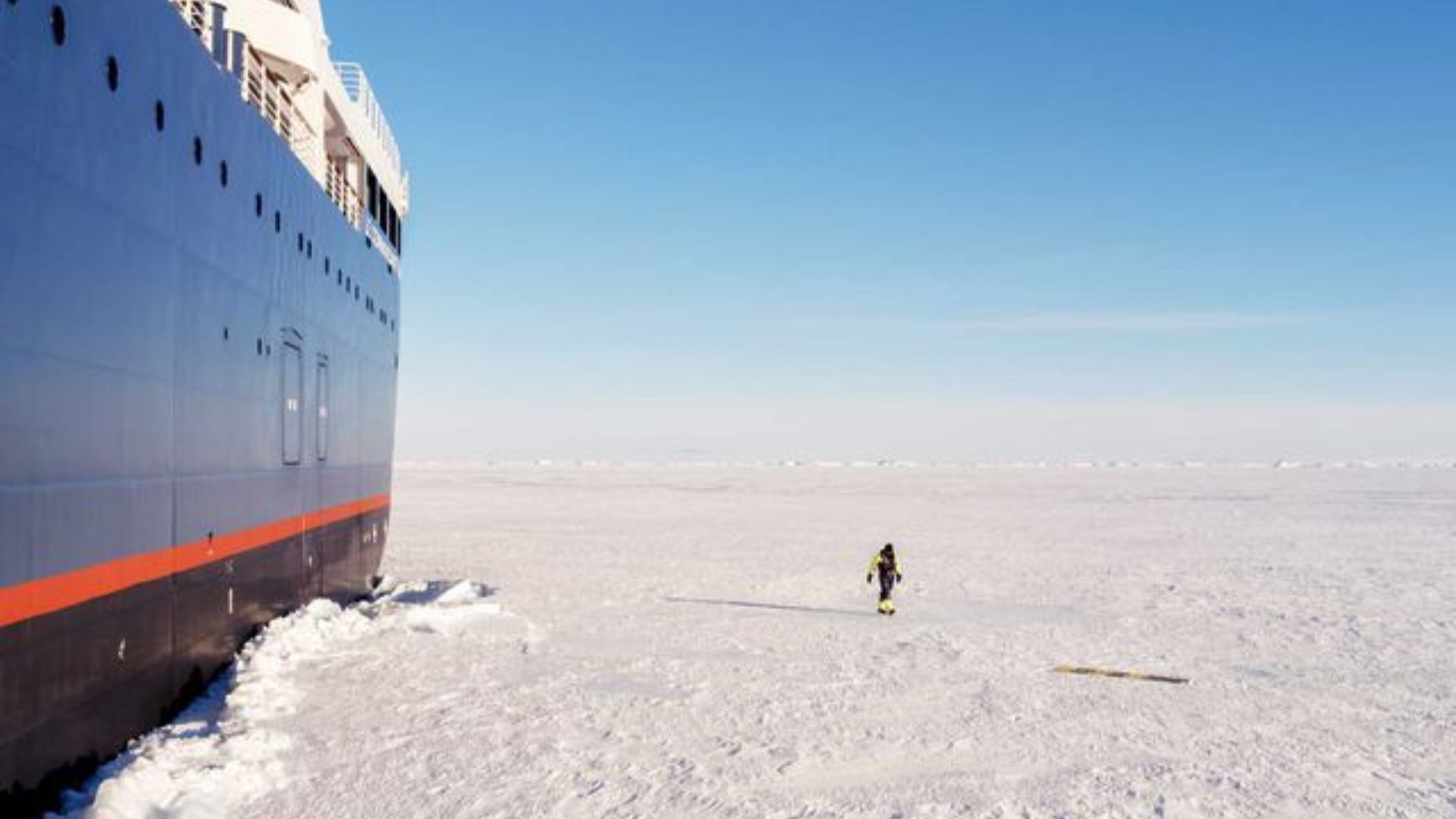
Just a week before we arrived in Antarctica by cruise, in a coincidence that would haunt me throughout my voyage on the Charcot, the Falklands Maritime Heritage Trust, led by British polar explorer John Shears, discovered the wreck of Shackleton’s ship, the Endurance, beneath the Weddell Sea. At almost 10,000 feet, it was surprisingly intact. In the chiaroscuro footage recorded by an autonomous underwater vehicle, you can see the stern, still adorned with the ship’s name. For more than a century, bizarre anemones have claimed its deck and deep-sea squat lobsters have peered through its portholes.
A three-masted sailing ship, the Endurance carried Shackleton and his team to the Antarctic just as World War I was brewing. Norwegian explorer Roald Amundsen and his British counterpart, Captain Robert Falcon Scott, had raced one another to the pole only three years before; Scott and two of his companions had died on their way back. Not wanting to be outdone, Shackleton set himself the goal of crossing the continent, from one side to another, by dogsled. Legend has it that an advertisement for expedition members was published in the London Times — “Men wanted for hazardous journey, small wages, bitter cold, long months of complete darkness, constant danger, safe return doubtful, honour and recognition in case of success.” There were said to be 5,000 applicants. Twenty-seven set out. It turned out they might have been safer in the trenches of France.
Nothing prepares you for Antarctica. It is a continent of superlatives, the world’s most extreme environment, alien, surreal, elemental, a place of magnificence and spectacle. The coldest, windiest, driest, and highest continent on earth, it exists within its own unique parameters of dramatic shifts in temperature, of vast icebergs calving away from the mainland beneath colossal skies.
We had entered the Weddell Sea in the predawn. The Charcot’s passengers were all up on deck like eager schoolchildren. All about us were islands composed of sensuous white drifts of snow and ice, broken here and there by the hard edges of bare black rock. Flotillas of icebergs filled the bay, majestic, tabular, an unearthly blue, their brows armoured and castellated, their flanks polished and carved into sculptural forms. Then the dawn began to filter colour over the scene, pink and orange and the most subtle rose, stealing across the icebergs one by one, and draping distant white provinces, the polar approximations of prairies and valleys and mountain ranges, with delicate light.
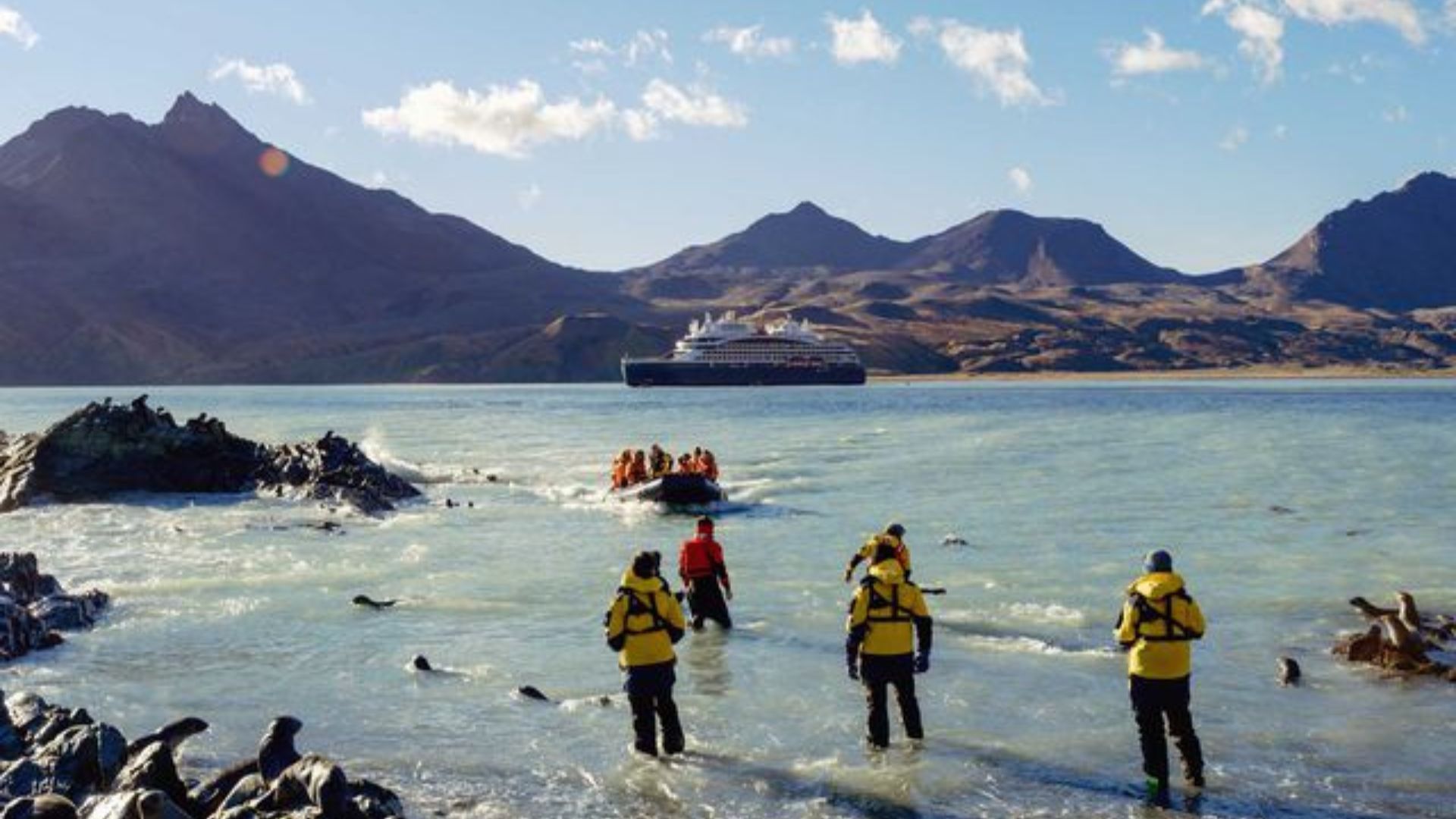
Kitted up in thermals and cruise-issue parkas and boots, we went ashore in Zodiac inflatable boats. A leopard seal, twice the size of a man, followed us to the beach, spinning beneath the water. Fur seals muttered complaints as we arrived, while Adélie penguins waddled about, pointedly ignoring us. On a saddle ridge, I sat on a boulder to admire the vast reach of the continent, swathed in snow, rolling away into white infinities.
The old sailors were wrong. This place didn’t feel Godless. It is humans who are missing here, like a world that was paused on the fifth day of creation, as if God had suddenly decided to keep this pristine place for himself. In Antarctica, it is easy to feel like a trespasser on some divine estate.
From the decks of the Charcot, we spotted whales several times a day, swimming alongside the ship. Sometimes there were hundreds — humpbacks, Antarctic minkes, fin whales, and orcas.
It was ice that spelled the end of the road for Shackleton and his crew of 27 men. By January of 1915, the Endurance had become trapped in the frozen waters of the Weddell Sea.
For 10 long months, the sounds of its death throes became part of their lives. The Endurance seemed to moan and wail in the grip of the ice; bending like canes under the pressure, the timbers shrieked. Finally, on November 21, the men watched the ship slip away beneath the dark water. All was suddenly and eerily silent. They were alone at the end of the world, without a ship and without any hope of rescue.
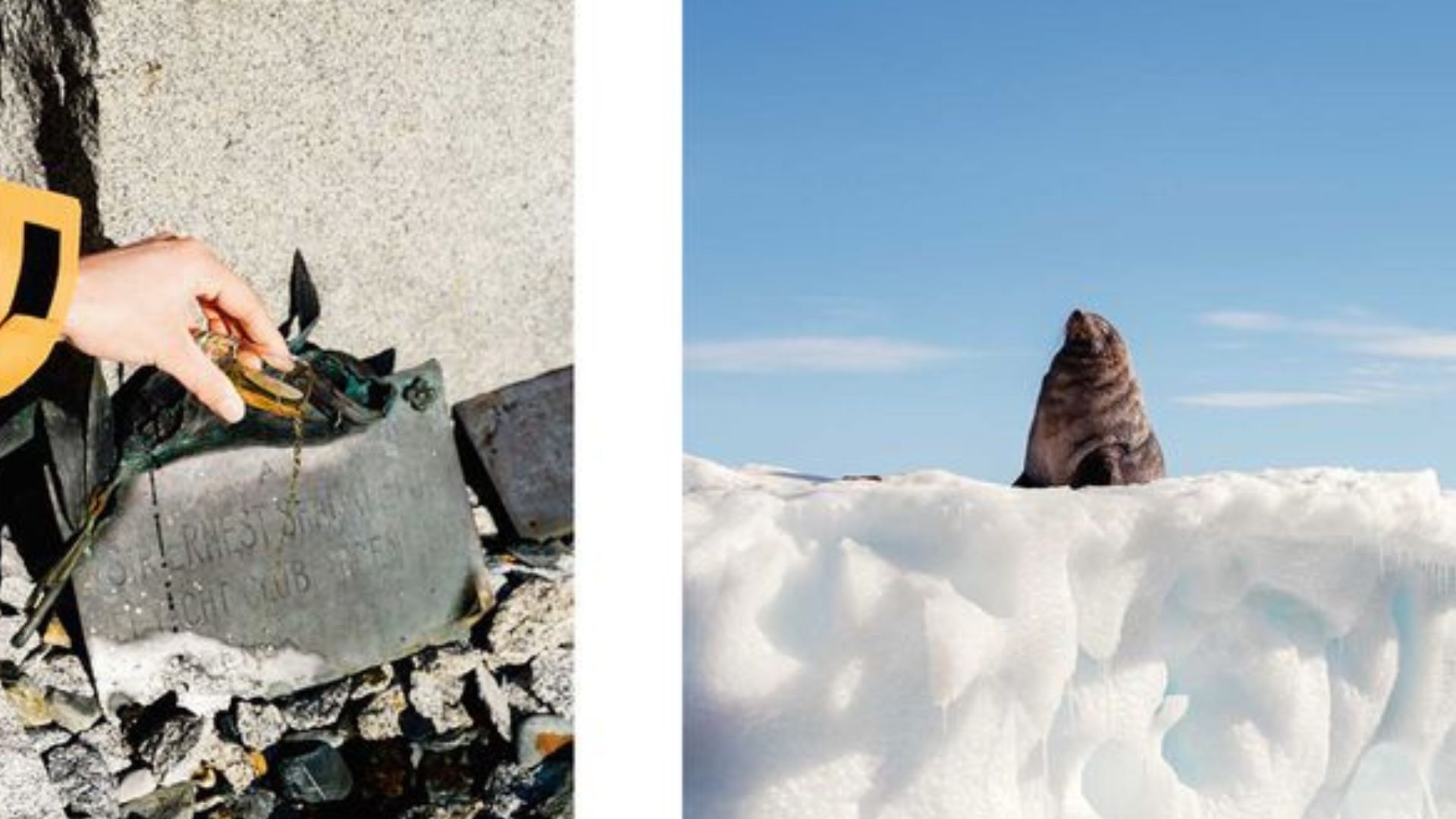
With their remaining supplies in three lifeboats and dogsleds, they hauled the vessels over the great ridges formed when ice floes collide, heading north in hopes of reaching the open sea. Their progress was painfully slow. Their chances of survival, they all knew, were negligible.
For the next two days, we skirted the Antarctic Peninsula on the cruise Charcot, sailing past a cavalcade of icebergs, each more extraordinary than the one before. On some, parties of seals had landed to bask in the polar sun. On others, penguins stood about in small earnest groups, as if waiting for a meeting to start.
Every day we went ashore to hike along the coastlines, to stroll among the fur seals and the penguins and the elephant seals, all of them strangely innocent, unperturbed by our presence. One day we climbed a ridge to look down on our ship, tiny in a bay of massive icebergs. Another day we hiked across sea ice, feeling dwarfed by the scale of the place. I thought about Shackleton and his men dragging those lifeboats behind them, their progress each day measured in yards.
From the decks of the Charcot, we spotted whales several times a day, swimming alongside the ship. Sometimes there were hundreds — humpbacks, Antarctic minkes, fin whales, and orcas, their spouts rising from the sea and the dorsal fins following, as their broad backs curved between the waves. Finally, they would lift their tails and dive, disappearing into their element. I imagined them singing, far below in the fathomless depths.
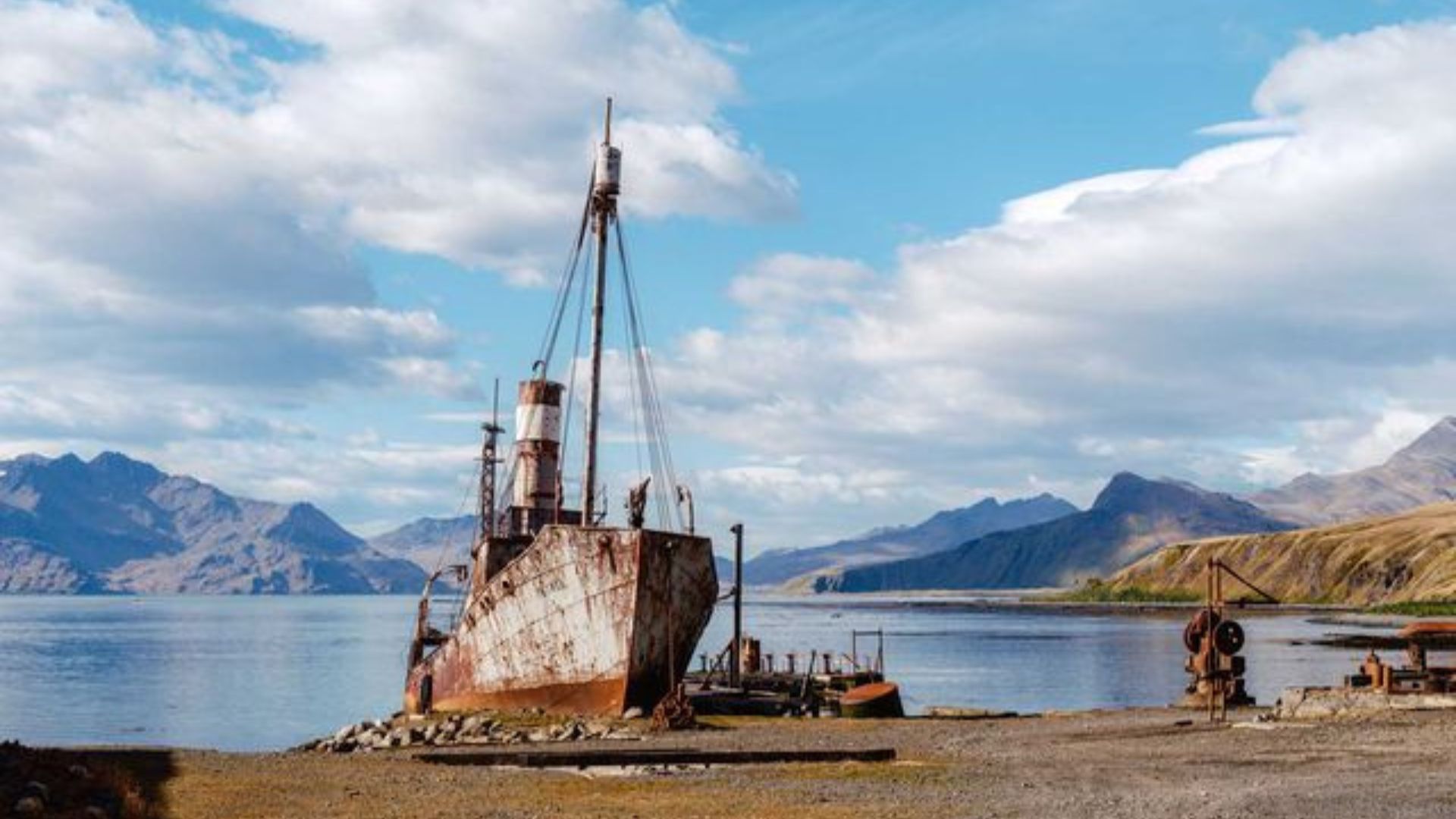
Life aboard settled into a delightful pattern. Between shore landings, there were fine meals at the ship’s two restaurants, one an expansive buffet, the other à la carte, overseen by the French chef Alain Ducasse. There were concerts and spa appointments, films and yoga classes and talks in the theatre given by the specialists who led our shore excursions — naturalists, marine biologists, photographers, historians, ornithologists, and hiking guides. In the spa, there was a sauna; on the ninth deck were two swimming pools — one indoor, one outdoor — and heated seats for sitting out in the sun. In the evenings, cocktails and champagne were served in the two lounges, where a pianist played Chopin before dinner and jazz afterwards.
From the boat, South Georgia seemed to rise from the sea like an ancient bronze treasure, scarred and luminous.
Designed by the renowned French architects Jean-Michel Wilmotte and Jean-Philippe Nuel, the Charcot’s interiors are airy and elegant. Floor-to-ceiling windows bring Antarctica to your bedside and your breakfast table. Natural materials abound — blond wood, pale fabrics, stone, marble. The ship is full of serious artwork; the collection of ceramics alone is world-class.
But of course, any ship is really about the people. The Charcot’s international staff made everyone feel like they were part of some old-fashioned neighbourhood where people still take the time to pause and chat. This is the joy of a small ship. The Charcot carries a maximum of only 245 passengers, served by 215 staff and crew.

The small Ponant fleet is owned by Groupe Artémis, the Pinault family’s portfolio of luxury brands that includes Yves Saint Laurent and Gucci, as well as the auction house Christie’s. Long admired for their commitment to tackling climate change, the Pinaults ensured that the Charcot, which launched in November of 2021, would be a standard-bearer for environmental sustainability.
A hybrid electric vessel, it runs on liquefied natural gas, the greenest fossil fuel on the market, while an energy-recovery network fuels the heating and the hot water as well as the swimming pools. (Ponant is working to introduce a yet more eco-friendly biogas element into the ship’s fuel supply.) Waste is only unloaded at ports of call, while microfiltration systems produce drinking water by reverse osmosis. The Charcot is also one of the quietest ships operating in the polar regions, thus reducing the impact of noise pollution on marine life.
But it is not just a cruise ship to Antarctica. The Charcot takes its responsibilities to the polar regions seriously. In the two onboard labs, a team of scientists gather real-time data about the polar regions to relay to research centres like the Massachusetts Institute of Technology and the French National Center for Scientific Research. Guest scientists are also invited on cruises: during our trip, a group from the University of Toronto was monitoring microplastics, sweeping the ocean for samples on each of our shore excursions.
The British conservationist and broadcaster Sir David Attenborough has made wildlife documentaries on all seven continents, yet declared visiting South Georgia to be the experience of his lifetime. One of the most remote islands on earth, just over a hundred miles long, it has been called the Serengeti of the South Atlantic. In the southern autumn — I visited at the end of March — much of the island is ice-free, offering nesting opportunities to a range of polar species.
From the boat, South Georgia seemed to rise from the sea like an ancient bronze treasure, scarred and luminous. Gravel shorelines swept inland through glens and dales that rose to sharp glaciated peaks. All was heathery in colour, reminiscent of the Scottish Highlands — tweedy greens and browns, verdigris and rust. There are only about 30 residents on the island, all temporary and most of them are researchers or staff of the island’s government. (Like its nearest neighbour, the Falkland Islands, South Georgia is a British overseas territory.)
Antarctica is at our mercy. This is one of the planet’s most vulnerable habitats. Ironically the coldest place on earth is ground zero for global warming. Temperatures are rising three times faster here than anywhere else on earth. Any acceleration of these trends would prove catastrophic for ocean levels across the world.
Over the course of three fine days, we made six landings on South Georgia, each more spectacular than the last. At Fortuna Bay, fur seal pups bounded playfully in and out of the water like spaniels. Mountain peaks framed high glaciers. Silver skeins of water cascaded from rocky heights while below, adult seals lay stretched out like sunbathers on a Mediterranean beach. At the far end of the bay, massive elephant seals snoozed, using one another as pillows. A male stirred and set off down the beach. Said to weigh up to 8,800 pounds — more than the average pickup truck — the creature humped along for five or six yards, like a colossal caterpillar, then paused to catch his breath before starting again, his thick rolls of fat rippling like liquid.
At Gold Harbour, we were unexpectedly shrouded in an afternoon fog. As we approached the shore we could hear a muffled chatter echoing eerily through the screens of mist until, at the very last moment, thousands of king penguins materialized like ghosts along the shore. At St. Andrews Bay, we walked around the inlet, crossing a fast, grey river of glacial melt, then climbing a grassy ridge to look down on a rookery of some 300,000 penguins, a great black and white assembly stretching as far as the eye could see. Huddled in their midst were their woolly brown young, while patrolling the edges of the colony were giant petrels almost three feet tall, their scavenging eyes watching for weakness or injury.
At the old whaling station of Grytviken, seals lazed about among the cluster of whitewashed buildings — a church, a post office, barracks, a museum — and the litter of old rusting tanks and half-sunken ships left behind by the whaling industry, which operated there from 1904 to 1965. I walked up to the cemetery where humble crosses stood enclosed by a white picket fence. At the back, I found the simple gravestone of Ernest Shackleton.

It is the irony of the Shackleton expedition that it is now viewed as a remarkable success. There was no crossing of the continent, no magnificent first, no explorer’s derring-do. But the fact that he and his men were able to escape the clutches of Antarctica, after the loss of their ship, is now seen as one of the great tales of polar survival.
Dragging the loaded lifeboats across the ice proved a Herculean task. Eventually, in April of 1916, almost six months after they had set out from their lost ship, the ice broke apart and they were able to launch the three lifeboats back into the water. In these small open vessels, in temperatures that often fell to -20 degrees Fahrenheit, they spent a week in nightmarish seas before finally staggering ashore on Elephant Island.
Shackleton decided that he and five other men would try to reach South Georgia in one of the lifeboats to get help, while the rest stayed behind. For the next 17 days, they crossed one of the most savage oceans on earth, soaked by ice water, beset with hurricane-force winds, facing the largest waves Shackleton had seen in 26 years at sea. And after landing on the island, they still had to trek across the mountains to reach the whaling stations on the opposite coast.
It is the irony of the Shackleton expedition that it is now viewed as a remarkable success. There was no crossing of the continent, no magnificent first, no explorer’s derring-do. But the fact that he and his men were able to escape the clutches of Antarctica, after the loss of their ship, is now seen as one of the great tales of polar survival.
Three and a half months after being left behind on Elephant Island, their food supply and their hopes almost at an end, the castaways saw a speck on the horizon. It was Shackleton, returning with a ship to rescue them.
Still compelled by his White South, undaunted by the narrow escape of his previous Antarctic quest, Shackleton mounted a second expedition five years later. But anchored off South Georgia, en route to Antarctica, he suffered a fatal heart attack and was buried, at the request of his wife, in the cemetery at Grytviken. In his diary, the ship’s surgeon wrote that it was where he would have wanted to be, “standing lonely on an island far from civilisation, surrounded by stormy tempestuous seas, in the vicinity of one of his greatest exploits.”
There were many things I thought about when I was back in the world of people and cities and busy-ness. I thought about Shackleton, about Flaubert, about penguins, and quite a lot about the madeleines they served with afternoon tea on board the Charcot.
“Travel makes one modest,” Flaubert wrote. “You see what a tiny place you occupy in the world.” Penguins make us modest, too. Much of the time they acted as if we didn’t really exist. If one waddled in my direction, it would come within a few feet, then pause and make a minor detour around me. To these creatures, I was little more than a boulder.
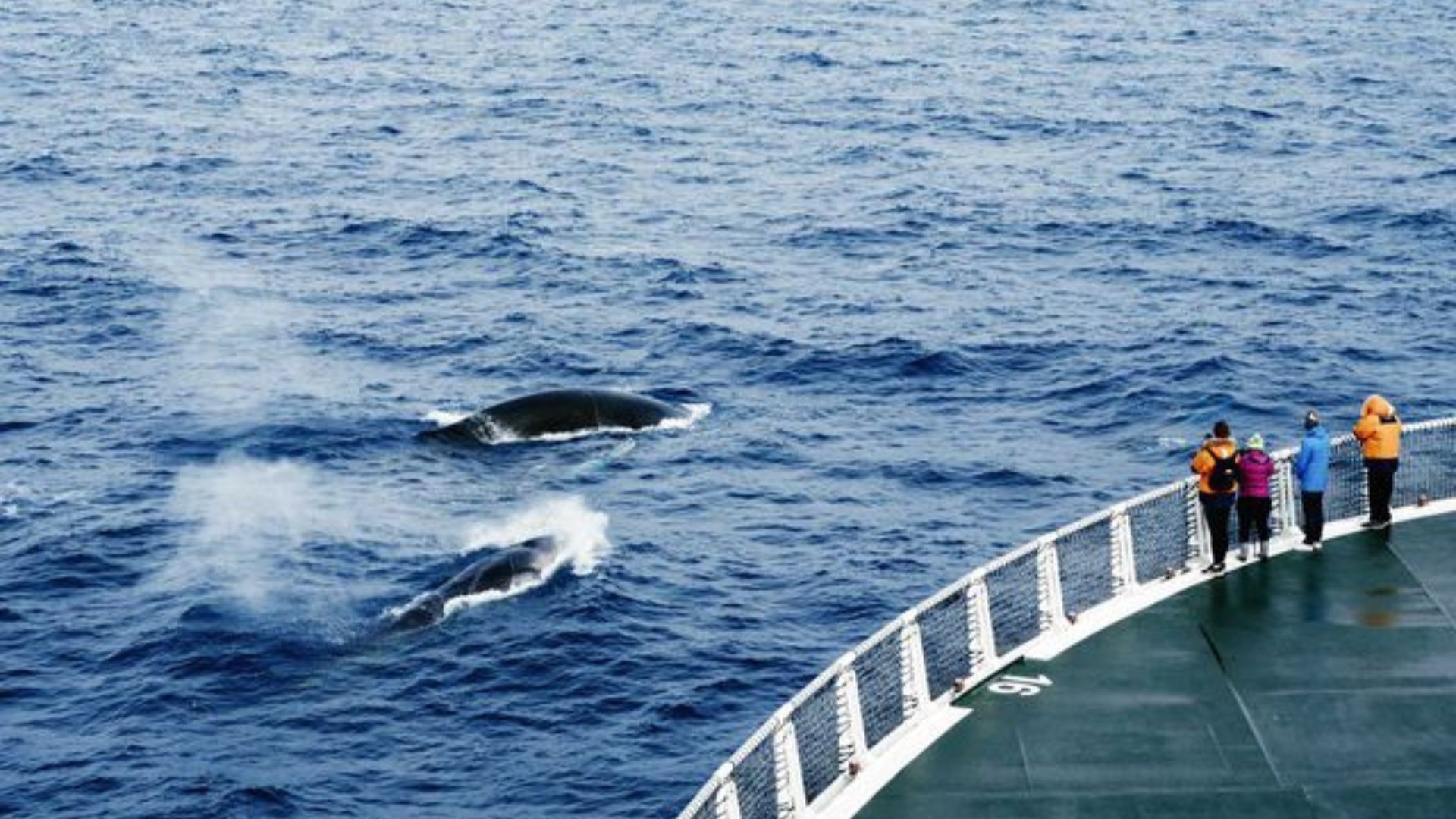
The penguins could be a metaphor for Antarctica. It seems indifferent to us. It makes no concession to human existence, offers no facilities, no toehold for human habitation. Antarctica is humbling, in the way Flaubert meant. And being humbled is good for us.
But in reality, Antarctica is at our mercy. It is not doomed by nature, as Captain Cook suggested, but it is in grave danger of being doomed by mankind. This is one of the planet’s most vulnerable habitats. Ironically the coldest place on earth is ground zero for global warming. Temperatures are rising three times faster here than anywhere else on earth. Any acceleration of these trends would prove catastrophic for ocean levels across the world. If we fail to address global warming, the melting of Antarctic ice will mean that, by the end of the century, cities like Miami and Bangkok will not survive in their current form.
Le Commandant Charcot has made a good start in developing ways to shield this vulnerable place from our polluting imprint. Though the demand for polar cruising has never been higher, there is a great deal more to be done in the management of travel, and in the mammoth task of reducing our carbon footprint.
They teach the story of Shackleton’s expedition in management courses, of how the men survived against tremendous odds. Among polar explorers, he is seen as the exemplar of determination and crisis management. The world now needs to harness the spirit of Shackleton, to find inspiration in the crew’s titanic struggle for survival. We too are facing dramatic odds if this fantastic place is to survive. It can be done. We can find solutions. We can change our behaviour. The White South, this pristine place, with which our fate is so closely bound, is depending on us.
The 18-day In the Footsteps of Shackleton and the Endurance cruise aboard Le Commandant Charcot starts at USD 27,040 per person, all-inclusive.
This story first appeared on www.travelandleisure.com
Main and Feature Image Credit: Carol Sachs
Related: Bookmark This: 16 Unique Festivals To Witness Once In A Lifetime



